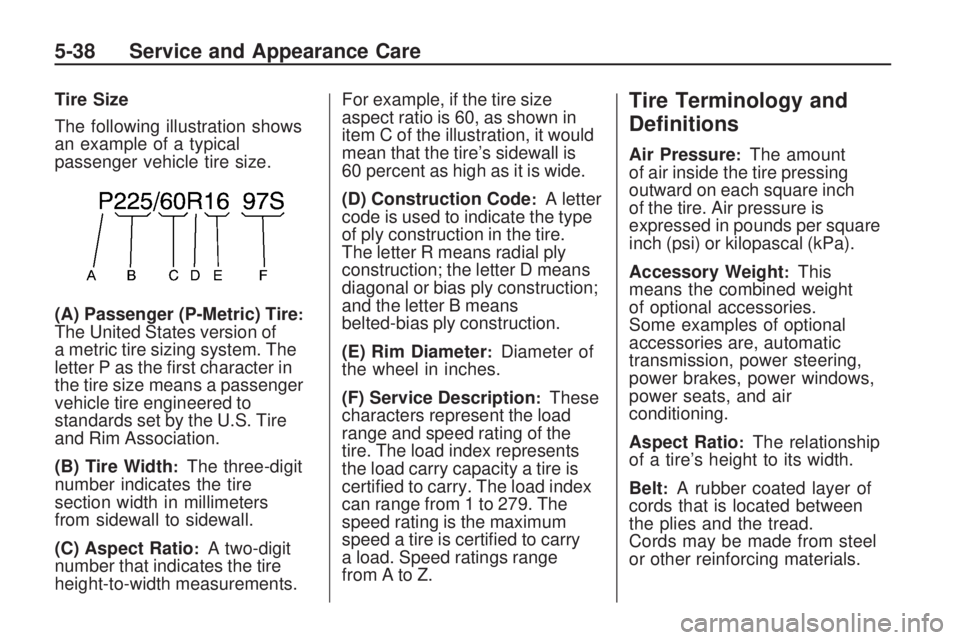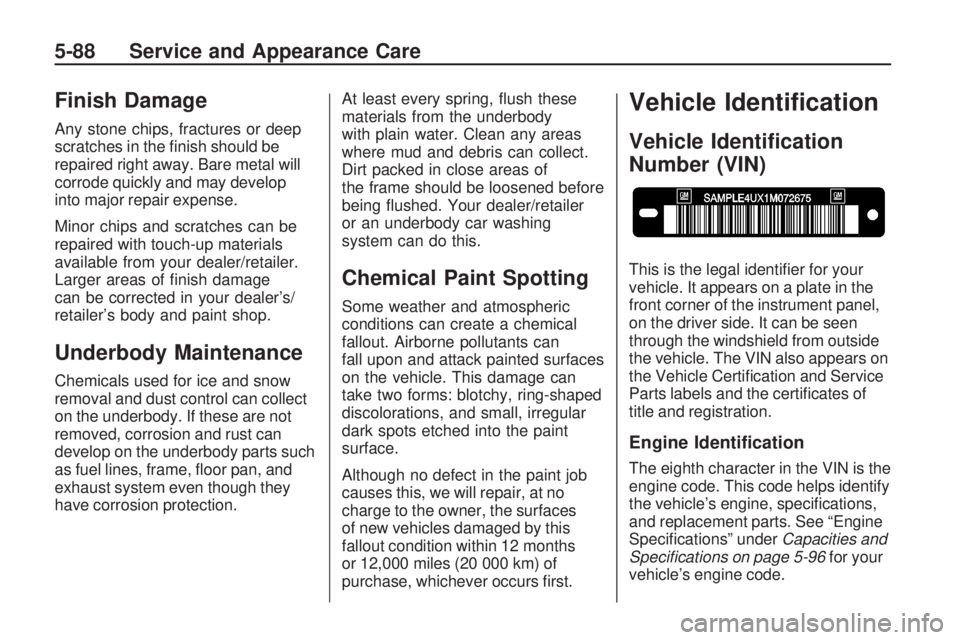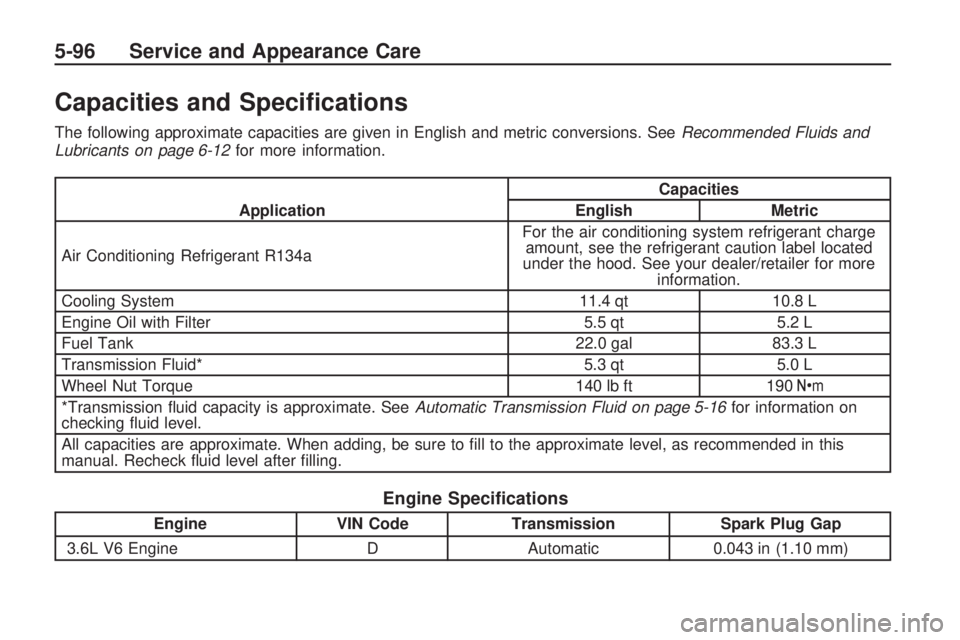engine GMC ACADIA 2009 Owners Manual
[x] Cancel search | Manufacturer: GMC, Model Year: 2009, Model line: ACADIA, Model: GMC ACADIA 2009Pages: 420, PDF Size: 2.23 MB
Page 308 of 420

10. Now start the vehicle with the
good battery and run the
engine for a while.
11. Try to start the vehicle that had
the dead battery. If it will not
start after a few tries, it probably
needs service.
Notice:If the jumper cables
are connected or removed in the
wrong order, electrical shorting
may occur and damage the
vehicle. The repairs would not be
covered by your warranty. Always
connect and remove the jumper
cables in the correct order,
making sure that the cables do not
touch each other or other metal.A. Heavy, Unpainted Metal Engine
Part or Remote Negative (−)
Terminal
B. Good Battery or Remote
Positive (+) and Remote
Negative (−) Terminals
C. Dead Battery or Remote
Positive (+) TerminalTo disconnect the jumper cables
from both vehicles, do the following:
1. Disconnect the black negative (−)
cable from the vehicle that had
the dead battery.
2. Disconnect the black negative (−)
cable from the vehicle with the
good battery.
3. Disconnect the red positive (+)
cable from the vehicle with the
good battery.
4. Disconnect the red positive (+)
cable from the other vehicle. Jumper Cable Removal
5-32 Service and Appearance Care
Page 314 of 420

Tire Size
The following illustration shows
an example of a typical
passenger vehicle tire size.
(A) Passenger (P-Metric) Tire
:The United States version of
a metric tire sizing system. The
letter P as the �rst character in
the tire size means a passenger
vehicle tire engineered to
standards set by the U.S. Tire
and Rim Association.
(B) Tire Width
:The three-digit
number indicates the tire
section width in millimeters
from sidewall to sidewall.
(C) Aspect Ratio
:A two-digit
number that indicates the tire
height-to-width measurements.For example, if the tire size
aspect ratio is 60, as shown in
item C of the illustration, it would
mean that the tire’s sidewall is
60 percent as high as it is wide.
(D) Construction Code
:A letter
code is used to indicate the type
of ply construction in the tire.
The letter R means radial ply
construction; the letter D means
diagonal or bias ply construction;
and the letter B means
belted-bias ply construction.
(E) Rim Diameter
:Diameter of
the wheel in inches.
(F) Service Description
:These
characters represent the load
range and speed rating of the
tire. The load index represents
the load carry capacity a tire is
certi�ed to carry. The load index
can range from 1 to 279. The
speed rating is the maximum
speed a tire is certi�ed to carry
a load. Speed ratings range
fromAtoZ.
Tire Terminology and
De�nitions
Air Pressure:The amount
of air inside the tire pressing
outward on each square inch
of the tire. Air pressure is
expressed in pounds per square
inch (psi) or kilopascal (kPa).
Accessory Weight
:This
means the combined weight
of optional accessories.
Some examples of optional
accessories are, automatic
transmission, power steering,
power brakes, power windows,
power seats, and air
conditioning.
Aspect Ratio
:The relationship
of a tire’s height to its width.
Belt
:A rubber coated layer of
cords that is located between
the plies and the tread.
Cords may be made from steel
or other reinforcing materials.
5-38 Service and Appearance Care
Page 322 of 420

TPMS Sensor Matching
Process
Each TPMS sensor has a unique
identi�cation code. Any time
you rotate your vehicle’s tires or
replace one or more of the TPMS
sensors, the identi�cation codes will
need to be matched to the new
tire/wheel position. The sensors are
matched to the tire/wheel positions
in the following order: driver side
front tire, passenger side front tire,
passenger side rear tire, and
driver side rear tire using a TPMS
diagnostic tool. See your dealer/
retailer for service.
The TPMS sensors can also be
matched to each tire/wheel position
by increasing or decreasing the
tire’s air pressure. If increasing the
tire’s air pressure, do not exceed
the maximum in�ation pressure
indicated on the tire’s sidewall.
To decrease air-pressure out of a
tire you can use the pointed end of
the valve cap, a pencil-style air
pressure gage, or a key.You have two minutes to match
the �rst tire/wheel position, and
�ve minutes overall to match
all four tire/wheel positions. If it
takes longer than two minutes, to
match the �rst tire and wheel, or
more than �ve minutes to match all
four tire and wheel positions the
matching process stops and you
need to start over.
The TPMS sensor matching process
is outlined below:
1. Set the parking brake.
2. Turn the ignition switch to
ON/RUN with the engine off.
3. Press the Remote Keyless
Entry (RKE) transmitter’s LOCK
and UNLOCK buttons at the
same time for approximately
�ve seconds. The horn sounds
twice to signal the receiver
is in relearn mode and TIRE
LEARNING ACTIVE message
displays on the DIC screen.
4. Start with the driver side front tire.5. Remove the valve cap from the
valve cap stem. Activate the
TPMS sensor by increasing or
decreasing the tire’s air pressure
for �ve seconds, or until a horn
chirp sounds. The horn chirp,
which may take up to 30 seconds
to sound, con�rms that the sensor
identi�cation code has been
matched to this tire and wheel
position.
6. Proceed to the passenger
side front tire, and repeat
the procedure in Step 5.
7. Proceed to the passenger
side rear tire, and repeat
the procedure in Step 5.
8. Proceed to the driver side rear
tire, and repeat the procedure in
Step 5. The horn sounds two
times to indicate the sensor
identi�cation code has been
matched to the driver side rear
tire, and the TPMS sensor
matching process is no longer
active. The TIRE LEARNING
ACTIVE message on the DIC
display screen goes off.
5-46 Service and Appearance Care
Page 331 of 420

If a Tire Goes Flat
It is unusual for a tire to blowout
while you are driving, especially
if you maintain the tires properly.
SeeTires on page 5-35.Ifair
goes out of a tire, It is much more
likely to leak out slowly. But if
you should ever have a blowout,
here are a few tips about what
to expect and what to do:
If a front tire fails, the �at tire will
create a drag that pulls the vehicle
toward that side. Take your foot off
the accelerator pedal and grip the
steering wheel �rmly. Steer to
maintain lane position, and then
gently brake to a stop well out of
the traffic lane.
A rear blowout, particularly on a
curve, acts much like a skid and may
require the same correction youwould use in a skid. In any rear
blowout, remove your foot from the
accelerator pedal. Get the vehicle
under control by steering the way
you want the vehicle to go. It may be
very bumpy and noisy, but you can
still steer. Gently brake to a stop, well
off the road if possible.
If a tire goes �at, avoid further tire
and wheel damage by driving slowly
to a level place and stopping.
1. Turn on the hazard warning
�ashers. SeeHazard Warning
Flashers on page 3-5.
2. Park the vehicle. Set the parking
brake �rmly and put the shift
lever in P (Park).
3. Turn off the engine.
4. Inspect the �at tire.{CAUTION
Lifting a vehicle and getting under
it to do maintenance or repairs is
dangerous without the appropriate
safety equipment and training. If a
jack is provided with the vehicle, it
is designed only for changing a
�at tire. If it is used for anything
else, you or others could be badly
injured or killed if the vehicle slips
off the jack. If a jack is provided
with the vehicle, only use it for
changing a �at tire.
This vehicle may come with a jack
and spare tire or a tire sealant
and compressor kit. To use the jack
and spare tire, seeChanging a
Flat Tire on page 5-69. To use the
tire sealant and compressor kit,
seeTire Sealant and Compressor
Kit on page 5-56.
Service and Appearance Care 5-55
Page 332 of 420

Tire Sealant and
Compressor Kit
{CAUTION
Idling a vehicle in an enclosed
area with poor ventilation is
dangerous. Engine exhaust may
enter the vehicle. Engine exhaust
contains Carbon Monoxide (CO)
which cannot be seen or smelled.
It can cause unconsciousness
and even death. Never run the
engine in an enclosed area that
has no fresh air ventilation. For
more information, seeEngine
Exhaust on page 2-30.
{CAUTION
Over-in�ating a tire could cause
the tire to rupture and you or
others could be injured. Be sure to
read and follow the tire sealant and
compressor kit instructions and
in�ate the tire to its recommended
pressure. Do not exceed the
recommended pressure.
{CAUTION
Storing the tire sealant and
compressor kit or other equipment
in the passenger compartment of
the vehicle could cause injury. In a
sudden stop or collision, loose
equipment could strike someone.
Store the tire sealant and
compressor kit in its original
location.If this vehicle has a tire sealant and
compressor kit, there may not be a
spare tire, tire changing equipment,
and on some vehicles there may not
be a place to store a tire.
The tire sealant and compressor
can be used to temporarily
seal punctures up to
1�4inch (6 mm)
in the tread area of the tire. It can
also be used to in�ate an under
in�ated tire.
If the tire has been separated from
the wheel, has damaged sidewalls,
or has a large puncture, the tire
is too severely damaged for the tire
sealant and compressor kit to be
effective. SeeRoadside Assistance
Program on page 7-6.
Read and follow all of the tire
sealant and compressor kit
instructions.
5-56 Service and Appearance Care
Page 345 of 420

Changing a Flat Tire
If a tire goes �at, avoid further
tire and wheel damage by driving
slowly to a level place. Turn on
the hazard warning �ashers.
SeeHazard Warning Flashers
on page 3-5.
{CAUTION
Changing a tire can be
dangerous. The vehicle can slip
off the jack and roll over or fall
on you or other people. You and
they could be badly injured or
even killed. Find a level place to
change your tire. To help prevent
the vehicle from moving:
1. Set the parking brake �rmly.
2. Put the shift lever in
P (Park).
(Continued)
CAUTION (Continued)
3. Turn off the engine and do
not restart while the vehicle
is raised.
4. Do not allow passengers to
remain in the vehicle.
To be even more certain the
vehicle will not move, you should
put blocks at the front and rear of
the tire farthest away from the
one being changed. That would
be the tire, on the other side, at
the opposite end of the vehicle.
When the vehicle has a �at tire (B),
use the following example as a
guide to assist you in the placement
of wheel blocks (A).A. Wheel Block
B. Flat Tire
The following information explains
how to use the jack and change
a tire.
Removing the Spare Tire
and Tools
The tools needed to remove the
spare tire are located in the storage
compartment on the driver side,
at the rear of the vehicle.
1. Open the jack storage
compartment by pulling on
the latch tab, located toward
the rear of the vehicle, and
pulling the cover off.
Service and Appearance Care 5-69
Page 364 of 420

Finish Damage
Any stone chips, fractures or deep
scratches in the �nish should be
repaired right away. Bare metal will
corrode quickly and may develop
into major repair expense.
Minor chips and scratches can be
repaired with touch-up materials
available from your dealer/retailer.
Larger areas of �nish damage
can be corrected in your dealer’s/
retailer’s body and paint shop.
Underbody Maintenance
Chemicals used for ice and snow
removal and dust control can collect
on the underbody. If these are not
removed, corrosion and rust can
develop on the underbody parts such
as fuel lines, frame, �oor pan, and
exhaust system even though they
have corrosion protection.At least every spring, �ush these
materials from the underbody
with plain water. Clean any areas
where mud and debris can collect.
Dirt packed in close areas of
the frame should be loosened before
being �ushed. Your dealer/retailer
or an underbody car washing
system can do this.
Chemical Paint Spotting
Some weather and atmospheric
conditions can create a chemical
fallout. Airborne pollutants can
fall upon and attack painted surfaces
on the vehicle. This damage can
take two forms: blotchy, ring-shaped
discolorations, and small, irregular
dark spots etched into the paint
surface.
Although no defect in the paint job
causes this, we will repair, at no
charge to the owner, the surfaces
of new vehicles damaged by this
fallout condition within 12 months
or 12,000 miles (20 000 km) of
purchase, whichever occurs �rst.
Vehicle Identi�cation
Vehicle Identi�cation
Number (VIN)
This is the legal identi�er for your
vehicle. It appears on a plate in the
front corner of the instrument panel,
on the driver side. It can be seen
through the windshield from outside
the vehicle. The VIN also appears on
the Vehicle Certi�cation and Service
Parts labels and the certi�cates of
title and registration.
Engine Identi�cation
The eighth character in the VIN is the
engine code. This code helps identify
the vehicle’s engine, speci�cations,
and replacement parts. See “Engine
Speci�cations” underCapacities and
Specifications on page 5-96for your
vehicle’s engine code.
5-88 Service and Appearance Care
Page 368 of 420

Relays Usage
LT/PWR/
SEATDriver Side Power
Seat Relay
RT/PWR/
SEATPassenger Side
Power Seat Relay
Relays Usage
PWR/
WNDWPower Windows
Relay
PWR/
COLUMNPower Steering
Column Relay
L/GATE Liftgate Relay
LCK Power Lock Relay
REAR/WSWRear Window
Washer Relay
UNLCK Power Unlock Relay
DRL2Daytime Running
Lamps 2 Relay
LT/UNLCKDriver Side Unlock
Relay
DRLDaytime Running
Lamps Relay
SPARE Spare
FRT/WSWFront Windshield
Washer RelayUnderhood Fuse Block
The underhood fuse block is located
in the engine compartment, on
the passenger side of the vehicle.
Lift the cover for access to the
fuse/relay block.
Notice:Spilling liquid on any
electrical components on
the vehicle may damage it.
Always keep the covers on
any electrical component.
To remove fuses, hold the end of the
fuse between your thumb and index
�nger and pull straight out. Relay Side
5-92 Service and Appearance Care
Page 369 of 420

FusesUsage
A/C
CLUTCH Air Conditioning
Clutch
ABS MTR Antilock Braking
System (ABS) Motor
AFS Adaptive Forward
Lighting System
AIRBAG Airbag SystemFuses Usage
AUX
POWER Auxiliary Power
AUX VAC PUMP Auxiliary Vacuum
Pump
AWD All-Wheel-Drive
System
BATT 1 Battery 1
Fuses Usage
BATT 2 Battery 2
BATT 3 Battery 3
ECM Engine Control
Module
ECM 1 Engine Control
Module 1
EMISSION 1 Emission 1
EMISSION 2 Emission 2 EVEN
COILS Even Injector Coils
FAN 1 Cooling Fan 1
FAN 2 Cooling Fan 2
FOG LAMP Fog Lamps
FSCM Fuel System Control
Module
HORN Horn
HTD WASH Heated Windshield
Washer Fluid
HTD MIR Heated Outside
Rearview Mirror
Service and Appearance Care 5-93
Page 372 of 420

Capacities and Speci�cations
The following approximate capacities are given in English and metric conversions. SeeRecommended Fluids and
Lubricants on page 6-12 for more information.
Application Capacities
English Metric
Air Conditioning Refrigerant R134a For the air conditioning system refrigerant charge
amount, see the refrigerant caution label located
under the hood. See your dealer/retailer for more information.
Cooling System 11.4 qt 10.8 L
Engine Oil with Filter 5.5 qt 5.2 L
Fuel Tank 22.0 gal 83.3 L
Transmission Fluid* 5.3 qt 5.0 L
Wheel Nut Torque 140 lb ft 190 Y
*Transmission �uid capacity is approximate. See Automatic Transmission Fluid on page 5-16for information on
checking �uid level.
All capacities are approximate. When adding, be sure to �ll to the approximate level, as recommended in this
manual. Recheck �uid level after �lling.
Engine Speci�cations
Engine VIN CodeTransmission Spark Plug Gap
3.6L V6 Engine DAutomatic 0.043 in (1.10 mm)
5-96 Service and Appearance Care